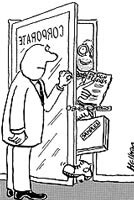Death of a salesman
Good design isn’t only about conception of ideas, as it must also address the actualities of directing those ideas to the marketplace.

Do many designers find that their great first stage work either ends up gathering dust in a job bag or being progressively compromised? Do planners or accounts people regularly find themselves staring at a yawning chasm between the initial strategic presentation and the lukewarm offering that ultimately went to market? Does management all too often have to seek consolation in the words “there’s always next time”?
Most of us now accept that the art of great design is not just about coming up with the idea and executing it beautifully. The real trick seems to be getting it to market. The expression “how did they come up with that” has effectively been replaced with “how did they get the client to go with that”. But herein lies a problem. The majority of people in design find it a real struggle to sell themselves, let alone try to sell a concept which is considered challenging.
So just how do innovative identities such as Go, Tesco Finest, or the BBC 1 balloon succeed where others do not? After all, with the greatest respect to the designers in question, it is conceivable that similar ideas could have emanated from another design business. It seems that it was the ability to make clients believe in their work that ultimately made the difference. I sense that clients go to the likes of Wolff Olins, Pentagram and Lambie-Nairn because they trust their creative judgement without reservation. The creative “sale” has actually happened before even handing over the brief!
So, it would seem, the first step to success is to “sell” what your business stands for before selling anything else. There is a widely held belief among clients that design businesses are not good at differentiating themselves from each other. Most would agree. If we sell similar looking work in a similar way then it becomes more and more difficult for clients to understand the nuances and have the confidence to go with the right concept.
Next we need an unfaltering courage in our own convictions (easier said than done). Our polite and tentative tendencies can make us vulnerable. If you enter a presentation prepared to go with whatever route dilates the clients’ pupils then you will end up feeling disappointed. Similarly, if you think “they’ll never go with this one” or use phrases such as “this one’s a bit of a flier”, the outcome to your apologetic approach is as certain as the cholesterol level of butter.
Successful creative salesmen must have total confidence. We need to leverage our expertise and believe we are worth listening to. Otherwise, the fear of losing a pitch, or worse still losing a client over a principle, will inevitably make us roll over and show our soft underbelly. Have we become too busy honing chameleon-like qualities whereby we change opinion to fit in with the environment? If you stand to lose a relationship for standing ground, then perhaps clients’ commitment was never really there in the first place.
And then try asking yourself if the right person is selling to the right person? Certainly, one of the biggest grievances within the industry is that design is not represented at a high enough level within client organisations, but perhaps the same is becoming true within design consultancies today. Often it is left for junior people to sell to junior people. Unless both sides are confident about what should be achieved you are effectively asking for compromise.
The shift from cottage industry to big business has in some ways led to a tier of design “reps”. They try as best they can to keep the client at bay while those best placed to create a vision and inspire client confidence find themselves dealing with pensions and company car policies. Look again to the aforementioned greats. Great work usually happens because it is sold passionately from the very top of the business.
It is ironic that today the majority of companies have some sort of dedicated sales resource which is doggedly doing everything it can to identify and convert potential clients. In light of the evidence, I wonder if the same effort and resource were directed into defining and communicating our own brand positionings, would the sort of work to which we individually aspire happen in a more effortless way?
Success, as they say, breeds success. Surely it would be far better to have clients knocking on your door, than to continue the thankless task of forever knocking on theirs.
Please e-mail comments for publication in the Opinion section to lyndark@centaur.co.uk
-
Post a comment



